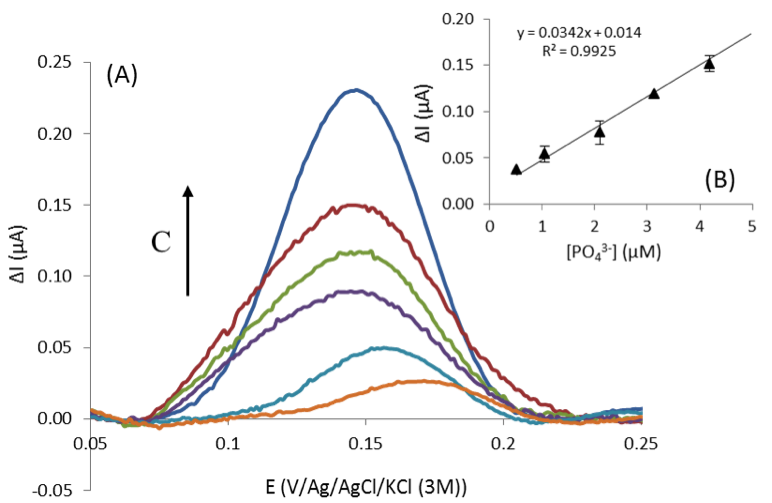Electrochemical phosphate detection
For phosphate detection, the challenge at the beginning of the SenseOCEAN project for CNRS-LEGOS was to adapt an electrochemical method other than chronoamperometry. Chronoamperomtry requires mechanical stirring of the solution which will not be possible in the final sensor for two reasons: the cell volume is too small and mechanical stirring costs too much energy. Cyclic voltammetry is not sensitive enough to detect phosphate in the open ocean concentration range. Hence, Square Wave Voltammetry (SWV) was selected because, as a pulse technique, SWV provides data of high quality and an enhanced sensitivity. This is due to a potential modulation (potential ramp combined with short-term potential pulses) and the way the current is sampled.
All the SWV parameters (frequency (⨍), amplitude (ESW), step potential (Estep)) used for phosphate determination in artificial seawater have been optimized with the open cell (see earlier article) in order to obtain well defined peaks, with the highest intensities. The results obtained with the scan rate of 2.5 mV/s are presented in Figure 1 (A).
The curve ΔI=f([PO43-]) in Figure 1 (B) shows a linear calibration curve for the whole concentration range (from 0.5 to 4.19 µM of PO43-) with a limit of quantification of 0.5 µmol/L. As the signal is a function of the scan rate, by increasing the scan rate to 250 mV/s, the limit of quantification has been decreased to 0.07 µmol/L with a linear behavior between 0.07 and 1 µmol/L of phosphate.

Figure 1: (A) Square wave voltammograms at 2.5 mV/s (⨍ = 2.5 Hz- Esw = 25 mV - Estep = 1 mV) on gold electrode (φ=3mm) obtained in artificial seawater containing 0.502, 1.04, 2.09, 3.14, 4.19 and 6.38 µmol/L of PO43- (B) Calibration curve (ΔI=f([PO43-]) for peak at E=0.15 V
All the parameters determined now have to be tested with the small volume prototype designed in the laboratory; the geometry of the prototype and the electrodes orientation may have an influence on phosphate determination, in particular on complex diffusion (Figure 2).

Figure 2: Prototype for phosphate detection – Volume ≈ 300 µL – External diameter ≈ 5 cm













